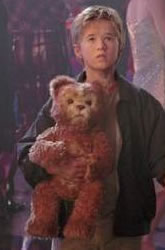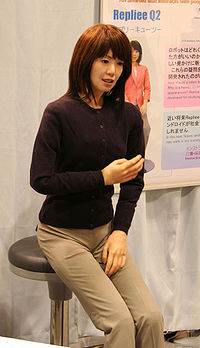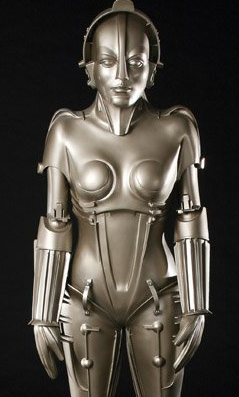|
|
 
|
|
Author
|
Topic: The Uncanny Valley, and its relation to movies
|
|
|
|
|
Randy Stankey
Film God

Posts: 6539
From: Erie, Pennsylvania
Registered: Jun 99
|
 posted 11-28-2009 11:09 PM
posted 11-28-2009 11:09 PM




I think this has a lot to do with people's expectation of reality more than the object in question's adherence to some real or imagined standard of reality.
We expect movies from the likes of Pixar to be hyper-realistic but we also know that they aren't real. Therefore we apply the principle of "Willing Suspension of Disbelief." Because of that, we will allow for some things to be unrealistic but other things will not be allowed because they approach too closely to the line between suspension of disbelief and actual belief.
On the other hand, if I showed you a photograph of a sunset over the ocean but the color of the sun was green instead of yellow or orange you would immediately dismiss it as being "bad" or "fake." This is because we expect a photograph to be realistic. A green sun is obviously fake and, unless there is a good reason for the discrepancy, it SHOULD be dismissed as fake. It does not fit our expectation of reality. However, if I told you that I Photoshopped the picture to make the sun look green you might be inclined to like it. You now have no expectation of reality and are willing to suspend disbelief for the sake of an artistic work.
When it comes to robots, we have the same principle at work.
Let's look at the Movie "A.I." by Stephen Speilberg:

Here, we have Haley Joel Osmet as "David" the robot boy accompanied by his toy "Teddy 3000."
We will accept an unrealistically animated Teddy Bear, even to the point of it being comical because we know Teddy Bears aren't alive. We will accept that "David" is real because he is played by a real human. However, if "David" moved with short, choppy motions like "Teddy" or if Teddy had smooth, fluid movements like a human, we would not accept either of them.
Our expectation of reality programs our willingness to suspend disbelief.
We can apply what we now understand to the robotic engineer, Masahiro Mori's assertion that robots can be "Too real."
A robot can look like a machine and we will accept it but, if it looks "too real" it will fall into the "valley of weirdness" that Mori describes. If a robot looks real but not "real enough" it won't be accepted. If a robot looks "exceptionally real" we will begin to accept it again.
I think this phenomenon is driven by our expectation of reality.
We know robots are machines. If it looks like a machine it is accepted. But remember, the human eye is extremely good at picking out synthetic motion.
Try an experiment: Look at yourself in the mirror. Turn your head from side to side, keeping your gaze fixed on your own image. Notice how your eyes move from side to side in order to "track" the image you want to see. Now go watch a scene from the movie "Christmas Carol" that we have been talking about. Notice whether the characters' eyes "track" as well as your eyes did when you were looking at your own image. Whether you consciously recognize it or not, you perceive that lack of reality in the character and you immediately pick the character out as "fake" whether or not you can quantify the reason.
We know that "Christmas Carol" is fake so we give it more leeway on the reality scale. But, if we were looking at a robot that was 99% realistic but its eyes did not "track" correctly we would instantly know it and call that robot "fake."
We expect Jim Carey's "Scrooge" to be fake so we will suspend disbelief but if we look at "Repliee Q2", the robot pictured in the Wikipedia article and we see the same lack of tracking in the eyes we will not like it because we expect it to look real and, therefore, will not suspend disbelief.
BTW: Repliee Q2's eyes do not look realistic, its hands are too big for the female character portrayed and its posture is too "stiff" for me to believe that it is real and call it a "she."
| IP: Logged
|
|
|
|
|
|
Randy Stankey
Film God

Posts: 6539
From: Erie, Pennsylvania
Registered: Jun 99
|
 posted 11-29-2009 01:19 PM
posted 11-29-2009 01:19 PM




I think you are right but Pixar, et. al., can get away with these techniques precisely because we have no expectation of reality.
We know toys can't move and talk by themselves. We know there isn't such a thing as a big, hairy, blue monster with horns and blue fur with purple spots. Because of that, we give in to the fantasy... suspension of disbelief. As long as something stays in that "suspendable" territory, the object or movie will be accepted.
When an object or movie gets close to that area where we would expect it to be real is where we get into the "uncanny valley" phenomenon. If we were presented with a realistic android we have an unconscious expectation that it will look, move and act in a realistic manner. Our expectation of realism makes us unwilling to suspend disbelief. Because the object is in "un-suspendable" territory we will not accept it if it is not up to our expectations of realism. In fact, we will scrutinize it even more closely.
You're right. Pixar and other animated movies do simplify their characters and take artistic license in creating and animating them. You're right, there are thousands of minuscule muscle contractions in the human face that make it look real or, for the lack of them, look fake. The human eye is incredibly good at picking them out.
I think you are onto something. Humans may have a hard-wired instinct to avoid other dead humans. Androids which are "too real" but "not real enough" may trigger it. You are talking about the basic reaction while I am referring to the reason why there is a "valley" in the belief curve.
The movie, "Christmas Carol" with the animated Scrooge is not believable because they tried to make him look too real but failed. Scrooge crossed the line of suspendibility, thus we do not accept him.
We're talking about the same thing from different perspectives.
| IP: Logged
|
|
Bobby Henderson
"Ask me about Trajan."

Posts: 10973
From: Lawton, OK, USA
Registered: Apr 2001
|
 posted 11-29-2009 02:07 PM
posted 11-29-2009 02:07 PM




I think so.
Some of the instinct side to which I refer comes from things my father and others have mentioned from being in combat. One of my newest co-workers, who was formerly a police officer, mentioned the same thing. When you see a dead body for real you may have the very strong urge to stay away from it. Even certain smells from a dead person, be it blood or decaying tissue, may trigger the urge to get the hell out of there even if you never see the body itself. I think this is instinct at work. You don't know what killed the person, and if disease is what caused it then you don't want to get infected either.
From an artistic standpoint, I don't see much purpose in creating CGI people that are photo-realistic. To me it's more interesting if they are cartoon caricatures the way Pixar designs them. I liked how PDI/Dreamworks handled some of the human characters in Monsters vs. Aliens, but they weren't quite as abstracted as the characters in certain Pixar movies, like Up.
Additionally, I wish the movie makers would consider some other non-realistic approaches to CGI animation. What about making a CGI movie in the style of a type of painting? I think it would be pretty cool to see an animated movie where the characters were "painterly" looking -like something out of a Monet painting. I've seen short subject animated films do stuff like that. But I can't recall ever seeing a feature length show take the approach, especially with CGI.
| IP: Logged
|
|
|
|
|
|
|
|
|
|
|
|
|
|
All times are Central (GMT -6:00)
|
|
Powered by Infopop Corporation
UBB.classicTM
6.3.1.2
The Film-Tech Forums are designed for various members related to the cinema industry to express their opinions, viewpoints and testimonials on various products, services and events based upon speculation, personal knowledge and factual information through use, therefore all views represented here allow no liability upon the publishers of this web site and the owners of said views assume no liability for any ill will resulting from these postings. The posts made here are for educational as well as entertainment purposes and as such anyone viewing this portion of the website must accept these views as statements of the author of that opinion
and agrees to release the authors from any and all liability.
|

 Home
Home
 Products
Products
 Store
Store
 Forum
Forum
 Warehouse
Warehouse
 Contact Us
Contact Us




 Printer-friendly view of this topic
Printer-friendly view of this topic






![[Razz]](tongue.gif)




![[Big Grin]](biggrin.gif)
![[beer]](graemlins/beer.gif)



![[thumbsup]](graemlins/thumbsup.gif)



